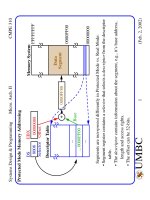Thiết kế và lập trình hệ thống - Chương 25
Bạn đang xem bản rút gọn của tài liệu. Xem và tải ngay bản đầy đủ của tài liệu tại đây (188.89 KB, 10 trang )
Systems Programming 80x86 Assembly VII CMPE 310
1 (March 27, 2000 10:41 pm)
UMBC
U M B C
U
N
I
V
E
R
S
I
T
Y
O
F
M
A
R
Y
L
A
N
D
B
A
L
T
I
M
O
R
E
C
O
U
N
T
Y
1
9
6
6
Intel Assembly
Procedures:
CALL: Pushes the address of the instruction following the CALL instruc-
tion onto the stack.
RET: Pops the address.
NEAR CALL:
Similar to NEAR jump instruction, e.g. 2nd and 3rd bytes of instruc-
tion contain displacement added to IP.
FAR CALL:
Similar to FAR jump instruction, e.g. 2nd and 3rd bytes of instruction
contain new IP while 4th and 5th bytes contain CS.
CALL BX and CALL [BX] versions also exist.
SUM PROC NEAR USES BX CX DX
ADD AX, BX
ADD AX, CX
MOV AX, DX
SUM ENDP
RET
Systems Programming 80x86 Assembly VII CMPE 310
2 (March 27, 2000 10:41 pm)
UMBC
U M B C
U
N
I
V
E
R
S
I
T
Y
O
F
M
A
R
Y
L
A
N
D
B
A
L
T
I
M
O
R
E
C
O
U
N
T
Y
1
9
6
6
Intel Assembly
Interrupts:
Hardware generated CALL: I/O Device
Software generated CALL: Internally derived from an instruction or
exception.
We will look at both of these.
Interrupt Vectors:
Real Mode: A 4 byte number stored in the first 1024 bytes of memory.
Protected Mode: A interrupt descriptor table is used instead.
Each descriptor is 8 bytes long.
There are 256 interrupt vectors.
Intel reserves the 0-31.
Interrupts 33-255 are user definable.
Vectors 1-6, 7, 9, 16 and 17 function in real and protected mode.
The rest function only in protected mode.
Systems Programming 80x86 Assembly VII CMPE 310
3 (March 27, 2000 10:41 pm)
UMBC
U M B C
U
N
I
V
E
R
S
I
T
Y
O
F
M
A
R
Y
L
A
N
D
B
A
L
T
I
M
O
R
E
C
O
U
N
T
Y
1
9
6
6
Intel Assembly
Interrupt Vectors:
Number Address Microprocessor Function
0 00-03 All Divide error
1 04-07 All Single step
2 08-0B All NMI pin
3 0C-0F All Breakpoint
4 10-13 All Interrupt on overflow
5 14-17 80186-Pentium Bound instruction (print screen)
6 18-1B 80186-Pentium Invalid opcode
7 1C-1F 80186-Pentium Coprocessor emulation
8 20-23 80386-Pentium Double fault (clock tick)
9 24-27 80386 Coprocessor segment overrun (keyboard)
A 28-2B 80386-Pentium Invalid task state segment (IRQ2)
B 2C-2F 80386-Pentium Segment not present (IRQ3)
C 30-33 80386-Pentium Stack fault (IRQ4)
D 34-37 80386-Pentium General protection fault (IRQ5)
E 38-3B 80386-Pentium Page fault (IRQ6)
F 3C-3F ----- Reserved (IRQ7)
10 40-43 80286-Pentium Floating-point error (Video)
11 44-47 80486SX Alignment check interrupt
12 48-4F Pentium Machine check exception
13-1F 50-7F --- Reserved
Systems Programming 80x86 Assembly VII CMPE 310
4 (March 27, 2000 10:41 pm)
UMBC
U M B C
U
N
I
V
E
R
S
I
T
Y
O
F
M
A
R
Y
L
A
N
D
B
A
L
T
I
M
O
R
E
C
O
U
N
T
Y
1
9
6
6
Intel Assembly
Interrupt Instructions.
Real mode: Fetches a vector from the vector table (address of ISR).
Protected mode: Fetches an interrupt descriptor (contains addr of ISR).
Similar to a FAR CALL: pushes both IP/EIP and CS onto stack.
3 types are available:
• INT
There are 256 software interrupt instructions.
The INT instruction takes a numeric operand: 0-255.
Real mode: It’s multiplied by 4 to get address of vector.
Protected mode: It’s multiplied by 8 (descriptors are 8 bytes long).
Systems Programming 80x86 Assembly VII CMPE 310
5 (March 27, 2000 10:41 pm)
UMBC
U M B C
U
N
I
V
E
R
S
I
T
Y
O
F
M
A
R
Y
L
A
N
D
B
A
L
T
I
M
O
R
E
C
O
U
N
T
Y
1
9
6
6
Intel Assembly
INT Instruction.
Processing sequence for an INT instruction:
• Push FLAGS.
• Clear T and I flag bits (hardware interrupts disabled).
• Push CS.
• Fetch new value for CS from interrupt vector.
• Push IP/EIP.
• Fetches new value of IP/EIP from vector.
• Jump to new location.
INT instruction is 2 bytes long.
Replaces FAR CALL, which is 5 bytes long.
Commonly used to call system functions. Decouples programs from
system function addresses.
IRET(Real)/IRETD(Protected):
Undoes call: POP IP/EIP, POP CS, POP FLAGS
Popping FLAGS restores T and I bits.









